Dangerous Goods.-
Dangerous goods’ clasification:
For every transport (maritime, air, ferry, by road or by interior sailing roads), the clasification of dangerous goods has been elaborated by the the UN Committee of Experts on the Transport of Dangerous Goods.
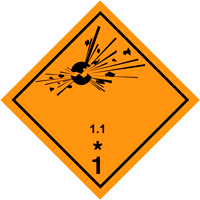 | Division 1.1 Substances and articles which have a mass explosion hazard. |
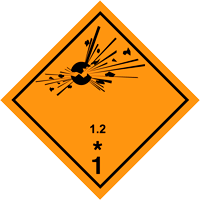 | Division 1.2 Substances and articles which have a projection hazard but not a mass explosion hazard. |
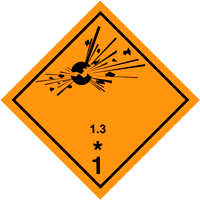 | Division 1.3 Substances and articles which have a fire hazard and either a minor blast hazard or a minor projection hazard or both. |
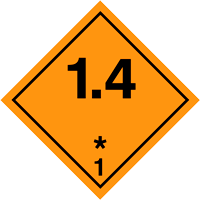 | Division 1.4 Substances and articles which present no significant hazard; only a small hazard in the event of ignition or initiation during transport with any effects largely confined to the package. |
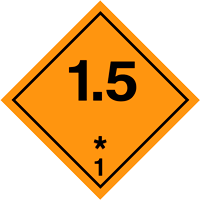 | Division 1.5 Very insensitive substances which have a mass explosion hazard. |
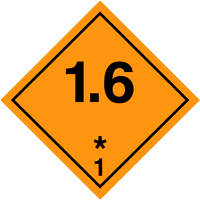 | Division 1.6 Extremely insensitive articles which do not have a mass explosion hazard. |
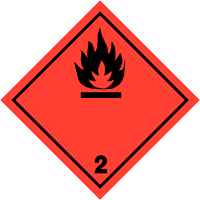 | Division 2.1 – Flammable Gas Gases which ignite on contact with an ignition source, such as acetylene, hydrogen, and propane. |
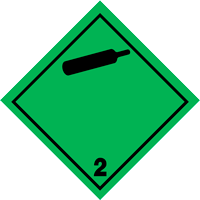 | Division 2.2 – Non-Flammable Gases Gases which are neither flammable nor poisonous. Includes the cryogenic gases/liquids (temperatures of below -100 °C) used for cryopreservation and rocket fuels, such as nitrogen, neon, and carbon dioxide. |
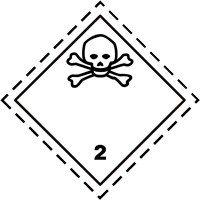 | Division 2.3 – Poisonous Gases Gases liable to cause death or serious injury to human health if inhaled; examples are fluorine, chlorine, and hydrogen cyanide. |
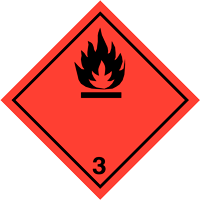 | Flammable Liquids Liquids, mixtures of liquids or liquids containing solids in solution or suspension which give off a flammable vapour (have a flash point) at temperatures of not more than 60-65°C, liquids offered for transport at temperatures at or above their flash point or substances transported at elevated temperatures in a liquid state and which give off a flammable vapour at a temperature at or below the maximum transport temperature. |
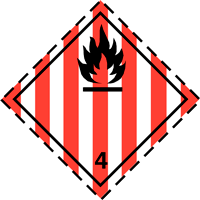 | Division 4.1 – Flammable Solids Solid substances that are easily ignited and readily combustible (nitrocellulose, magnesium, safety or strike-anywhere matches). |
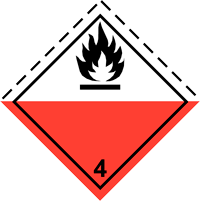 | Division 4.2 – Spontaneously Combustible Solid substances that ignite spontaneously (aluminium alkyls, white phosphorus). |
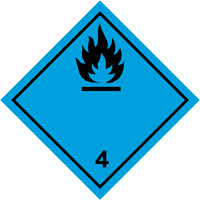 | Division 4.3 – Dangerous when Wet Solid substances that emit a flammable gas when wet or react violently with water (sodium, calcium, potassium, calcium carbide). |
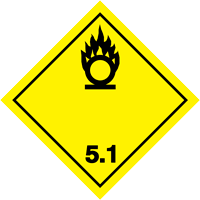 | Division 5.1 – Oxidizing Agent Oxidizing agents other than organic peroxides (calcium hypochlorite, ammonium nitrate, hydrogen peroxide, potassium permanganate). |
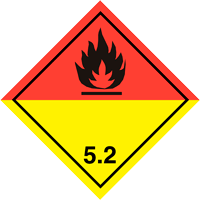 | Division 5.2 – Organic Peroxide Oxidizing Agent Organic peroxides, either in liquid or solid form (benzoyl peroxides, cumene hydroperoxide). |
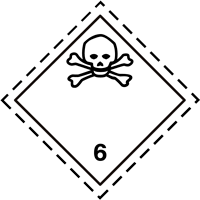 | Division 6.1 – Poison A.Toxic substances which are liable to cause death or serious injury to human health if inhaled, swallowed or by skin absorption (potassium cyanide, mercuric chloride). B.Toxic substances which are harmful to human health (N.B this symbol is no longer authorized by the United Nations) (pesticides, methylene chloride). |
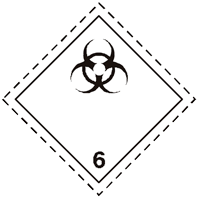 | Division 6.2 – Biohazard Biohazardous substances; the World Health Organization (WHO) divides this class into two categories: Category A: Infectious; and Category B: Samples (virus cultures, pathology specimens, used intravenous needles). |
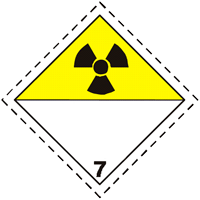 | Radioactive substances Radioactive substances comprise substances or a combination of substances which emit ionizing radiation (uranium, plutonium). |
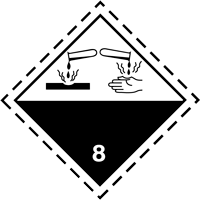 | CorrosiveCorrosive substances are substances that can dissolve organic tissue or severely corrode certain metals: 8.1 Acids: sulfuric acid, hydrochloric acid 8.2 Alkalis: potassium hydroxide, sodium hydroxide |
 | Miscellaneous Hazardous substances that do not fall into the other categories (asbestos, air-bag inflators, self inflating life rafts, dry ice). |
 | Division 1.1 Substances and articles which have a mass explosion hazard. |
 | Division 1.2 Substances and articles which have a projection hazard but not a mass explosion hazard. |
 | Division 1.3 Substances and articles which have a fire hazard and either a minor blast hazard or a minor projection hazard or both. |
 | Division 1.4 Substances and articles which present no significant hazard; only a small hazard in the event of ignition or initiation during transport with any effects largely confined to the package. |
 | Division 1.5 Very insensitive substances which have a mass explosion hazard. |
 | Division 1.6 Extremely insensitive articles which do not have a mass explosion hazard. |
 | Division 2.1 – Flammable Gas Gases which ignite on contact with an ignition source, such as acetylene, hydrogen, and propane. |
 | Division 2.2 – Non-Flammable Gases Gases which are neither flammable nor poisonous. Includes the cryogenic gases/liquids (temperatures of below -100 °C) used for cryopreservation and rocket fuels, such as nitrogen, neon, and carbon dioxide. |
 | Division 2.3 – Poisonous Gases Gases liable to cause death or serious injury to human health if inhaled; examples are fluorine, chlorine, and hydrogen cyanide. |
 | Flammable Liquids Liquids, mixtures of liquids or liquids containing solids in solution or suspension which give off a flammable vapour (have a flash point) at temperatures of not more than 60-65°C, liquids offered for transport at temperatures at or above their flash point or substances transported at elevated temperatures in a liquid state and which give off a flammable vapour at a temperature at or below the maximum transport temperature. |
 | Division 4.1 – Flammable Solids Solid substances that are easily ignited and readily combustible (nitrocellulose, magnesium, safety or strike-anywhere matches). |
 | Division 4.2 – Spontaneously Combustible Solid substances that ignite spontaneously (aluminium alkyls, white phosphorus). |
 | Division 4.3 – Dangerous when Wet Solid substances that emit a flammable gas when wet or react violently with water (sodium, calcium, potassium, calcium carbide). |
 | Division 5.1 – Oxidizing Agent Oxidizing agents other than organic peroxides (calcium hypochlorite, ammonium nitrate, hydrogen peroxide, potassium permanganate). |
 | Division 5.2 – Organic Peroxide Oxidizing Agent Organic peroxides, either in liquid or solid form (benzoyl peroxides, cumene hydroperoxide). |
 | Division 6.1 – Poison A.Toxic substances which are liable to cause death or serious injury to human health if inhaled, swallowed or by skin absorption (potassium cyanide, mercuric chloride). B.Toxic substances which are harmful to human health (N.B this symbol is no longer authorized by the United Nations) (pesticides, methylene chloride). |
 | Division 6.2 – Biohazard Biohazardous substances; the World Health Organization (WHO) divides this class into two categories: Category A: Infectious; and Category B: Samples (virus cultures, pathology specimens, used intravenous needles). |
 | Radioactive substances Radioactive substances comprise substances or a combination of substances which emit ionizing radiation (uranium, plutonium). |
 | CorrosiveCorrosive substances are substances that can dissolve organic tissue or severely corrode certain metals: 8.1 Acids: sulfuric acid, hydrochloric acid 8.2 Alkalis: potassium hydroxide, sodium hydroxide |
 | Miscellaneous Hazardous substances that do not fall into the other categories (asbestos, air-bag inflators, self inflating life rafts, dry ice). |

Division 1.1
Substances and articles which have a mass explosion hazard.

Division 1.2
Substances and articles which have a projection hazard but not a mass explosion hazard.

Division 1.3
Substances and articles which have a fire hazard and either a minor blast hazard or a minor projection hazard or both.

Division 1.4
Substances and articles which present no significant hazard; only a small hazard in the event of ignition or initiation during transport with any effects largely confined to the package.

Division 1.5
Very insensitive substances which have a mass explosion hazard.

Division 1.6
Extremely insensitive articles which do not have a mass explosion hazard.

Division 2.1 – Flammable Gas
Gases which ignite on contact with an ignition source, such as acetylene, hydrogen, and propane.

Division 2.2 – Non-Flammable Gases
Gases which are neither flammable nor poisonous. Includes the cryogenic gases/liquids (temperatures of below -100 °C) used for cryopreservation and rocket fuels, such as nitrogen, neon, and carbon dioxide.

Division 2.3 – Poisonous Gases
Gases liable to cause death or serious injury to human health if inhaled; examples are fluorine, chlorine, and hydrogen cyanide.

Flammable Liquids
liquids, mixtures of liquids or liquids containing solids in solution or suspension which give off a flammable vapour (have a flash point) at temperatures of not more than 60-65°C, liquids offered for transport at temperatures at or above their flash
point or substances transported at elevated temperatures in a liquid state and which give off a flammable vapour at a temperature at or below the maximum transport temperature.

Division 4.1 – Flammable Solids
Solid substances that are easily ignited and readily combustible (nitrocellulose, magnesium, safety or strike-anywhere matches).

Division 4.2 – Spontaneously Combustible
Solid substances that ignite spontaneously (aluminium alkyls, white phosphorus).

Division 4.3 – Dangerous when Wet
Solid substances that emit a flammable gas when wet or react violently with water (sodium, calcium, potassium, calcium carbide).

Division 5.1 – Oxidizing Agent
Oxidizing agents other than organic peroxides (calcium hypochlorite, ammonium nitrate, hydrogen peroxide, potassium permanganate).

Division 5.2 – Organic Peroxide Oxidizing Agent
Organic peroxides, either in liquid or solid form (benzoyl peroxides, cumene hydroperoxide).

Division 6.1 – Poison
A.Toxic substances which are liable to cause death or serious injury to human health if inhaled, swallowed or by skin absorption (potassium cyanide, mercuric chloride).
B.Toxic substances which are harmful to human health (N.B this symbol is no longer authorized by the United Nations) (pesticides, methylene chloride).

Division 6.2 – Biohazard
Biohazardous substances; the World Health Organization (WHO) divides this class into two categories: Category A: Infectious; and Category B: Samples (virus cultures, pathology specimens, used intravenous needles).

Radioactive substances
Radioactive substances comprise substances or a combination of substances which emit ionizing radiation (uranium, plutonium).

Corrosive
Corrosive substances are substances that can dissolve organic tissue or severely corrode certain metals:
8.1 Acids: sulfuric acid, hydrochloric acid
8.2 Alkalis: potassium hydroxide, sodium hydroxide

Miscellaneous
Hazardous substances that do not fall into the other categories (asbestos, air-bag inflators, self inflating life rafts, dry ice).
